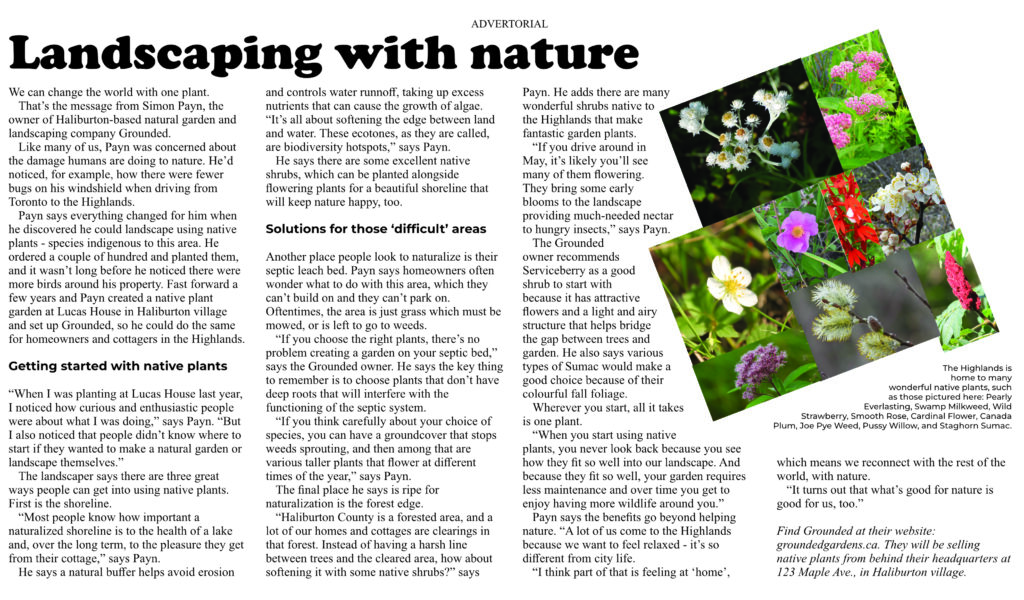
Native Plant Landscaping: Getting Started in Haliburton
We explore the benefits of native plant landscaping in Haliburton and how to get started at your home or cottage.
We can change the world with one plant.
That’s the message from Simon Payn, the owner of Haliburton-based natural garden and landscaping company Grounded.
Like many of us, Payn was concerned about the damage humans are doing to nature. He’d noticed, for example, how there were fewer bugs on his windshield when driving from Toronto to the Highlands.
Payn says everything changed for him when he discovered he could landscape using native plants – species indigenous to this area. He ordered a couple of hundred and planted them, and it wasn’t long before he noticed there were more birds around his property.
Fast forward a few years and Payn created a native plant garden at Lucas House in Haliburton village and set up Grounded, so he could do the same for homeowners and cottagers in the Highlands.
Getting started with native plants
“When I was planting at Lucas House last year, I noticed how curious and enthusiastic people were about what I was doing,” says Payn. “But I also noticed that people didn’t know where to start if they wanted to make a natural garden or landscape themselves.”
The native plant landscaper says there are three great ways people can get into using native plants. First is the shoreline.
“Most people know how important a naturalized shoreline is to the health of a lake and, over the long term, to the pleasure they get from their cottage,” says Payn.
He says a natural buffer helps avoid erosion and controls water runoff, taking up excess nutrients that can cause the growth of algae.
“It’s all about softening the edge between land and water. These ecotones, as they are called, are biodiversity hotspots,” says Payn.
He says there are some excellent native shrubs, which can be planted alongside flowering plants for a beautiful shoreline that will keep nature happy, too.
Landscaping for those ‘difficult’ areas
Another place people look to naturalize is their septic leach bed. Payn says homeowners often wonder what to do with this area, which they can’t build on and they can’t park on. Oftentimes, the area is just grass which must be mowed, or is left to go to weeds.
“If you choose the right plants, there’s no problem creating a garden on your septic bed,” says the Grounded owner. He says the key thing to remember is to choose plants that don’t have deep roots that will interfere with the functioning of the septic system.
“If you think carefully about your choice of species, you can have a groundcover that stops weeds sprouting, and then among that are various taller plants that flower at different times of the year,” says Payn.
The final place he says is ripe for native plant landscaping is the forest edge.
“Haliburton County is a forested area, and a lot of our homes and cottages are clearings in that forest. Instead of having a harsh line between trees and the cleared area, how about softening it with some native shrubs?” says Payn. He adds there are many wonderful shrubs native to the Highlands that make fantastic garden plants.
“If you drive around in May, it’s likely you’ll see many of them flowering. They bring some early blooms to the landscape providing much-needed nectar to hungry insects,” says Payn.
The Grounded owner recommends Serviceberry as a good shrub to start with because it has attractive flowers and a light and airy structure that helps bridge the gap between trees and garden. He also says various types of Sumac would make a good choice because of their colourful fall foliage.
Wherever you start, all it takes is one plant
“When you start using native plants, you never look back because you see how they fit so well into our landscape. And because they fit so well, your garden requires less maintenance and over time you get to enjoy having more wildlife around you.”
Payn says the benefits go beyond helping nature. “A lot of us come to the Highlands because we want to feel relaxed – it’s so different from city life.
“I think part of that is feeling at ‘home’, which means we reconnect with the rest of the world, with nature.
“It turns out that what’s good for nature is good for us, too.”
This article on native plant landscaping in Haliburton first appeared as an advertorial in Home in the Highlands, published by The Highlander.
